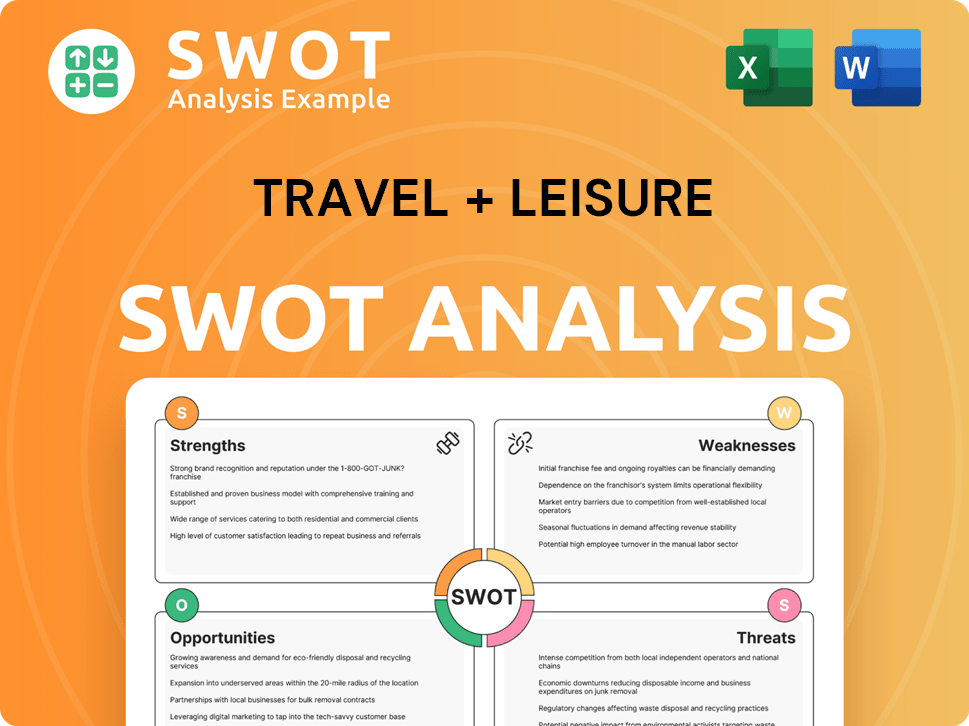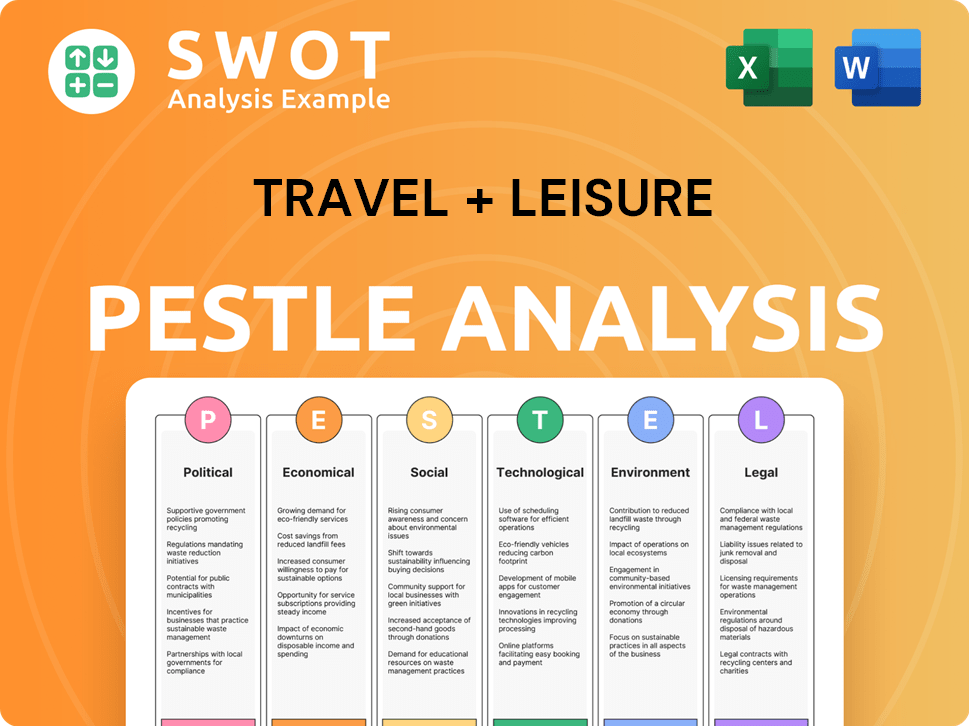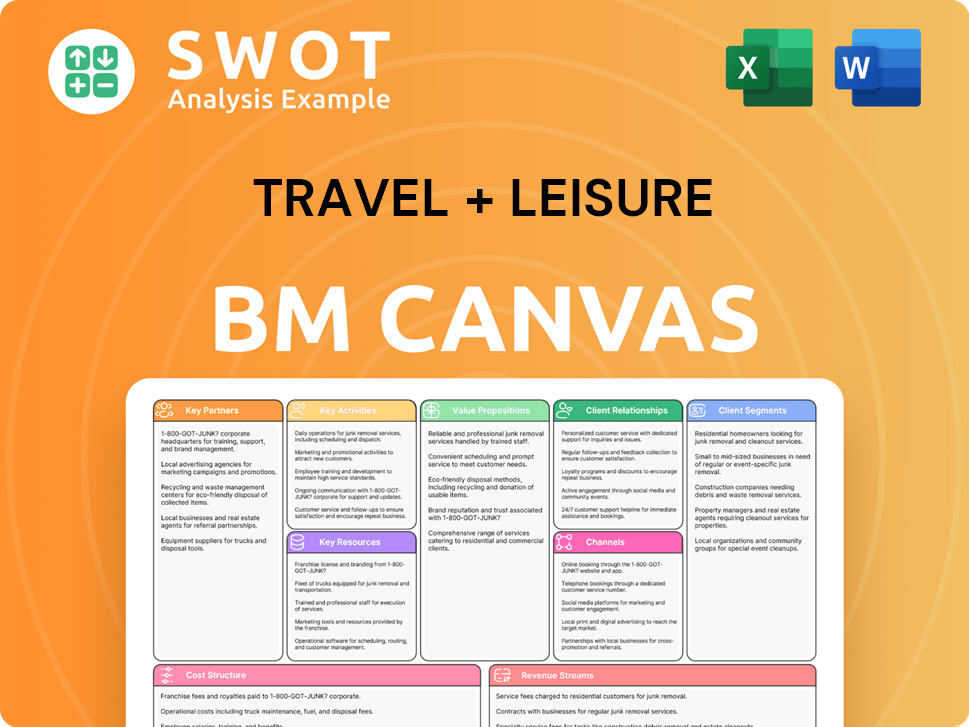Travel + Leisure Bundle
How Does Travel + Leisure Company Stay Ahead in the Hospitality Market?
Travel + Leisure Company, a major player in the global leisure travel sector, is on a mission to redefine vacations for millions. With a market cap of approximately $3.9 billion as of early 2025, the company offers a diverse portfolio including vacation ownership resorts and travel clubs. Understanding the Travel + Leisure SWOT Analysis is key to grasping its competitive advantages and strategic direction.

This deep dive into the Travel + Leisure business model will explore its core operations and revenue streams, which generated $3.9 billion in net revenue in 2024. From the Travel magazine to its timeshare industry offerings, we'll unpack how this company, serving over 800,000 timeshare owners, continues to innovate and adapt within the dynamic hospitality market, providing over six million vacations annually. We'll also examine its strategic moves and future outlook, answering questions like how does Travel + Leisure make money and what is their business strategy.
What Are the Key Operations Driving Travel + Leisure’s Success?
The Travel + Leisure Company operates through three main segments to deliver value: Vacation Ownership, Travel and Membership, and Licensing and Other Services. The Vacation Ownership segment is the core, focusing on developing, marketing, and selling vacation ownership interests (VOIs), providing consumer financing, and managing properties, with brands like Club Wyndham and Margaritaville Vacation Club. This segment showed strong performance in Q1 2025, with revenue up by 4% to $755 million and adjusted EBITDA up by 18% to $159 million.
The Travel and Membership segment offers vacation exchange services via RCI, manages resorts for third parties, and provides travel services such as subscription travel clubs like Travel + Leisure GO and online booking platforms. This segment also includes travel technology solutions and travel insurance. Although the Travel and Membership segment saw a 7% revenue decrease to $180 million in Q1 2025, the company is actively working on strategies to re-engage its members. The company's business model is diversified to cater to different travel preferences and needs.
The company's operational success is supported by a wide network of resorts, direct sales, online marketing, and customer service initiatives. Customer satisfaction is a priority, reflected in a customer retention rate of 87.3% and a Net Promoter Score of 68 in 2024. Its value proposition includes quality, flexibility, and value through its diverse portfolio, which includes timeshares, exchange programs, and branded travel services. This differentiates it within the timeshare industry and the broader hospitality market. To learn more about the target customer, read Travel + Leisure's Target Market.
The company's strategy involves strategic partnerships and acquisitions, such as the 2024 acquisition of Accor Vacation Club, to broaden its global reach and enhance its offerings. This approach helps in expanding the company's presence in the travel magazine and travel packages sectors.
- Vacation Ownership: Focuses on VOI sales, financing, and property management.
- Travel and Membership: Offers exchange services, resort management, and travel-related services.
- Licensing and Other Services: Includes brand licensing and other revenue streams.
- Customer Focus: High customer retention and Net Promoter Score indicate strong customer satisfaction.
Travel + Leisure SWOT Analysis
- Complete SWOT Breakdown
- Fully Customizable
- Editable in Excel & Word
- Professional Formatting
- Investor-Ready Format

How Does Travel + Leisure Make Money?
The Travel + Leisure Company's revenue streams are primarily divided into Vacation Ownership and Travel and Membership segments. The company leverages its strong brand recognition to generate revenue through various channels, including timeshare sales, travel club subscriptions, and licensing agreements. For the full year 2024, the company reported net revenues of $3.9 billion.
The Vacation Ownership segment is a key driver of revenue, with a significant portion of sales financed by the company. The Travel and Membership segment contributes through vacation exchange networks and travel booking services. The company also employs innovative monetization strategies, such as tiered pricing for membership programs and cross-selling travel services.
The company's business model is designed to capitalize on the growing demand for travel and leisure experiences. The company's focus is on providing diverse travel options and membership benefits to its customers. The company's financial performance is closely tied to the health of the hospitality market and the timeshare industry.
The Vacation Ownership segment is the largest revenue generator for the Travel + Leisure Company. Gross VOI sales increased by 6.7% in 2024, driven by an 8.0% increase in tours. In Q1 2025, this segment's revenue was $755 million, a 4% year-over-year increase. The company finances a significant portion of its VOI sales, with 71% of sales financed in 2024. Adjusted EBITDA for this segment surged by 18% to $159 million in Q1 2025.
- The Vacation Ownership segment includes the sale of timeshare interests.
- Consumer financing is a crucial component, facilitating sales and generating interest income.
- The segment's performance is closely tied to the demand for vacation properties and travel experiences.
- The company is focused on continued profitable growth in this segment.
The Travel and Membership segment includes vacation exchange networks, travel club subscriptions, and other travel booking services. Revenue decreased by 7% to $180 million in Q1 2025, due to a shift in member demographics. The adjusted EBITDA for this segment was $68 million in the same period. Key offerings include the Travel + Leisure GO subscription and the RCI timeshare exchange network. The company's business strategy includes offering various travel packages and membership options.
- The segment provides a range of travel services, catering to diverse customer needs.
- The Travel + Leisure GO subscription offers exclusive travel deals and benefits.
- RCI facilitates timeshare exchanges, enhancing the value of vacation ownership.
- The segment focuses on member retention and attracting new subscribers.
The Travel + Leisure Company employs various monetization strategies, including tiered pricing for membership programs and cross-selling travel services. Licensing agreements for resorts, hotels, and residential properties also contribute to revenue. In 2024, 88% of revenues were derived from the United States, with 12% from international operations. The company anticipates continued profitable growth in its vacation ownership business for 2025, with full-year Adjusted EBITDA projected to range from $955 million to $985 million. For more insights, explore the Competitors Landscape of Travel + Leisure.
- Tiered membership programs offer various levels of benefits at different price points.
- Cross-selling involves offering additional travel services, such as flights and car rentals.
- Licensing agreements leverage the brand's recognition to generate revenue.
- The company is focused on domestic growth, with a strong presence in the United States.
Travel + Leisure PESTLE Analysis
- Covers All 6 PESTLE Categories
- No Research Needed – Save Hours of Work
- Built by Experts, Trusted by Consultants
- Instant Download, Ready to Use
- 100% Editable, Fully Customizable

Which Strategic Decisions Have Shaped Travel + Leisure’s Business Model?
The Travel + Leisure Company has significantly evolved, marked by key milestones and strategic shifts. A pivotal move was the 2021 acquisition of the Travel + Leisure brand, which led to rebranding and expansion beyond traditional timeshares. This strategic pivot has reshaped the company's identity and market approach, broadening its appeal within the hospitality market.
In 2024, the acquisition of Accor Vacation Club for $50 million represents a crucial strategic initiative. This move expanded its presence in the Asia Pacific, Middle East, Africa, and Türkiye regions, adding 24 resorts and nearly 30,000 members. Furthermore, the company is developing sports-themed resorts under the Sports Illustrated Resorts brand, with sales expected to begin in 2025 and incremental growth starting in 2026. These initiatives highlight the company's commitment to diversification and growth within the timeshare industry.
Operationally, the company focuses on optimizing revenue from existing owners and enhancing the upgrade pipeline through new owner sales. Strategic restructuring has enhanced organizational efficiency, leading to cost savings. Despite facing economic uncertainties and a decline in the Travel and Membership segment, the company leverages its strong owner base and strategic initiatives to mitigate risks. To understand more about their marketing approach, you can read this article about the Marketing Strategy of Travel + Leisure.
The acquisition of the Travel + Leisure brand in 2021 was a pivotal moment, transforming the company's identity. The 2024 acquisition of Accor Vacation Club expanded the company's footprint. The company is also developing sports-themed resorts under the Sports Illustrated Resorts brand.
The Accor Vacation Club acquisition for $50 million in 2024 expanded the company's reach. The development of sports-themed resorts and a new Margaritaville resort in Orlando, set to open in 2027, demonstrates a commitment to diversification. The focus on optimizing revenue and restructuring for efficiency are also key strategic moves.
The company's brand recognition and extensive resort network of over 270 resorts worldwide are significant advantages. A loyal customer base of over 800,000 timeshare owners supports its stability. The company's commitment to customer satisfaction, reflected in an 87.3% retention rate in 2024, strengthens its position.
The Travel + Leisure business model is supported by diversified revenue streams. These include vacation ownership sales, resort operations, and exchange network fees. Product innovation, including new app launches, and leveraging relationships with Wyndham Hotels drive growth. The company continues to adapt and expand its offerings.
The company's competitive advantages stem from its strong brand recognition and extensive resort network. A loyal customer base and diversified revenue streams provide a stable business model. Customer satisfaction is high, indicated by an 87.3% retention rate in 2024.
- Strong brand recognition in the travel magazine and hospitality market.
- Extensive resort network with over 270 resorts worldwide.
- A loyal customer base of more than 800,000 timeshare owners.
- Diversified revenue streams from various sources.
Travel + Leisure Business Model Canvas
- Complete 9-Block Business Model Canvas
- Effortlessly Communicate Your Business Strategy
- Investor-Ready BMC Format
- 100% Editable and Customizable
- Clear and Structured Layout

How Is Travel + Leisure Positioning Itself for Continued Success?
The Travel + Leisure Company holds a prominent position in the timeshare and leisure travel industry, recognized as a leading vacation ownership and membership travel company globally. As of February 2025, the company's market capitalization is approximately $3.9 billion. The company's diverse portfolio, including timeshare properties, travel clubs, and branded travel services, differentiates it within the competitive landscape. With a loyal customer base exceeding 1.5 million users, Travel + Leisure has a strong brand presence.
This company faces several risks and headwinds, including economic uncertainty, declining consumer sentiment, and potential market slowdowns. Competition from other timeshare developers, short-term vacation options, and new entrants in the travel services market also poses challenges. Moreover, regulatory changes and inherent risks in the travel industry, such as severe weather events or pandemics, could impact operations. The Travel and Membership segment has experienced a revenue decline due to shifts in member demographics, highlighting a structural issue.
The company is a leading player in the timeshare industry. It offers a variety of travel services, including vacation ownership and membership programs. Its strong brand and extensive network of resorts contribute to its competitive advantage. Learn more about the Brief History of Travel + Leisure.
Key risks include economic uncertainty, declining consumer sentiment, and increased competition. The company also faces regulatory changes and inherent travel industry risks. Revenue declines in the Travel and Membership segment represent a structural challenge.
The company projects Adjusted EBITDA between $955 million and $985 million for 2025. Strategic initiatives include growing core businesses like Club Wyndham and WorldMark. The company plans to continue its asset-light strategy and maintain dividend growth.
Focus on growing Club Wyndham and WorldMark, expanding Margaritaville Vacation Club, and launching Sports Illustrated Resorts. The company will continue its asset-light strategy in vacation ownership. Dividend growth is planned, with a recommended increase to $0.56 per share for Q1 2025.
For 2025, the company anticipates Adjusted EBITDA between $955 million and $985 million. The company plans to spend between $150 million and $180 million on vacation ownership development in 2025. The primary focus is on increasing earnings and free cash flow by capitalizing on the sustained demand for leisure travel and adapting to changing consumer preferences.
- Continued growth of Club Wyndham and WorldMark.
- Expansion of Margaritaville Vacation Club.
- Launch of sales for Sports Illustrated Resorts.
- Maintaining dividend growth.
Travel + Leisure Porter's Five Forces Analysis
- Covers All 5 Competitive Forces in Detail
- Structured for Consultants, Students, and Founders
- 100% Editable in Microsoft Word & Excel
- Instant Digital Download – Use Immediately
- Compatible with Mac & PC – Fully Unlocked

Related Blogs
- What are Mission Vision & Core Values of Travel + Leisure Company?
- What is Competitive Landscape of Travel + Leisure Company?
- What is Growth Strategy and Future Prospects of Travel + Leisure Company?
- What is Sales and Marketing Strategy of Travel + Leisure Company?
- What is Brief History of Travel + Leisure Company?
- Who Owns Travel + Leisure Company?
- What is Customer Demographics and Target Market of Travel + Leisure Company?
Disclaimer
All information, articles, and product details provided on this website are for general informational and educational purposes only. We do not claim any ownership over, nor do we intend to infringe upon, any trademarks, copyrights, logos, brand names, or other intellectual property mentioned or depicted on this site. Such intellectual property remains the property of its respective owners, and any references here are made solely for identification or informational purposes, without implying any affiliation, endorsement, or partnership.
We make no representations or warranties, express or implied, regarding the accuracy, completeness, or suitability of any content or products presented. Nothing on this website should be construed as legal, tax, investment, financial, medical, or other professional advice. In addition, no part of this site—including articles or product references—constitutes a solicitation, recommendation, endorsement, advertisement, or offer to buy or sell any securities, franchises, or other financial instruments, particularly in jurisdictions where such activity would be unlawful.
All content is of a general nature and may not address the specific circumstances of any individual or entity. It is not a substitute for professional advice or services. Any actions you take based on the information provided here are strictly at your own risk. You accept full responsibility for any decisions or outcomes arising from your use of this website and agree to release us from any liability in connection with your use of, or reliance upon, the content or products found herein.